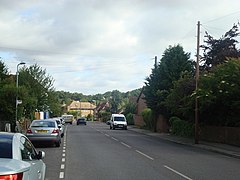Hextable
| Hextable | |
|---|---|
 Main Road, Hextable |
|
| Hextable shown within Kent | |
| Area | 1.98 km2 (0.76 sq mi) |
| Population | 4,092 (2011) |
| • Density | 2,067/km2 (5,350/sq mi) |
| OS grid reference | TQ517703 |
| • London | 15 mi (24 km) WNW |
| Civil parish |
|
| District | |
| Shire county | |
| Region | |
| Country | England |
| Sovereign state | United Kingdom |
| Post town | SWANLEY |
| Postcode district | BR8 |
| Dialling code | 01322 |
| Police | Kent |
| Fire | Kent |
| Ambulance | South East Coast |
| EU Parliament | South East England |
| UK Parliament | |
| Website | Hextable Parish Council |
Hextable is a village and civil parish in the Sevenoaks District of Kent, England. It lies north of Swanley and south of Dartford.
The origin of the village name goes back to Saxon times.
Its first documented appearance is in 1203 when the land is referred to as Hagestaple. Staple is from the Old English (O.E.) word "stapol," or boundary post. This makes perfect sense as the land was on the boundary of the Saxon settlements of Dartford, Bromley and Sutton at Hone. The word Hage is less clear. One theory is that it is descended from the O.E. word for high: "Hey." But the land on the Birchwood side of Hextable, where the post would have been, is not high, at least compared with nearby Rowhill and Swanley Village, and it is hard to see how Hage would have derived from Hey. The O.E. word "hage" meant a hedge, an enclosure or hawthorn, any of which could have been a means of uniquely delineating the boundary post in some way. The means by which Hagestaple became Hextable is in contrast well-documented:
The village grew up in late Victorian times with the selling off of Hextable Farm in 1870 (prior to this there were only three houses on the land that now comprises the village). It was originally set up as an area for the well-to-do to live in fine villas. Many of these villas are still standing, although two, Southbank and Newbank in College Road, were recently demolished to make way for flats and townhouses. The village's to-date most famous resident, Arthur Mee, known for the Children's Encyclopedia, lived in one such villa, St David's. His most famous utterance on his home village was the withering, although a little inaccurate, statement "Hextable has no history!"
The village quickly grew beyond being just a retreat for the upper middle class with the coming of the railway at nearby Swanley Junction coupled with the fertility of the land and the mild climate. Nurseries were established in the area with their produce being quickly sent to London via rail. Many of the names of these now long-gone nurseries still persist in road names such as Emerson and Panters. Emersons Avenue was built upon "The Rec", an old recreation ground left by a resident in Victorian times "for the use of the children of the village in perpetuity". It is consistent with the fast-changing nature of Hextable that perpetuity only lasted 100 years. The railway drove the expansion of the village in the 20th century as a convenient dormitory village for north-west Kent and London, and this is its main purpose today.
...
Wikipedia

